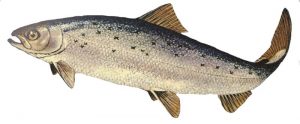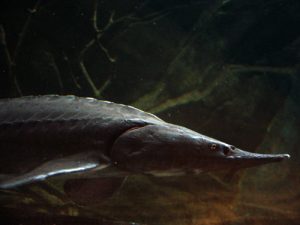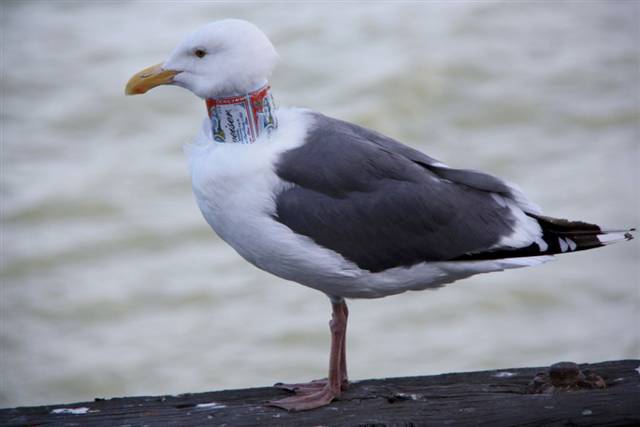Category Archives: Environmental
Red Lionfish Being Caught in Keys: Over 650 Reeled In:
There are now 659 less Indo-Pacific red lionfish calling the tranquil waters of the Florida Keys National Marine Sanctuary home.
The end to a bunch of lionfish derbies was held this past Saturday off the lower keys. As you know, these lionfish have been making quite a nuisance of themselves for the past little while, and efforts have been made to get rid of the little rascals, whether it be simple catching, netting in, and even pan frying.
Diving teams managed to round up 109 of these dastardly invaders, adding to the tally of lionfish brought in froIndo-Pacific red lionfish m the previous derbies in Key Largo and Marathon.
Lionfish which are muscling their way into the waters off the southeast United States, Bahamas and Caribbean are causing harm to the native species to those waters as they are chowing down on vital reef species, such as snapper and grouper.
A spokesperson for the Reef Education Foundation, Lad Atkins, has commented that lionfish don’t have any natural enemies, except for us humans.
Salmon Seen Leaping From Waters of the River Derwent for the First Time in Two Centuries

After two centuries and 80 kilometers inland, an amazing thing has happened on one of the largest rivers in Britain – a salmon was seen leaping its way upstream to spawn.
This amazing thing – which is more common in Scotland and Canada – was seen in Derbyshire on the Rover Derwent.
The salmon – which would have swum to the ends of the earth just to spawn and perish – had an easier time making its way up the river due to the higher water levels because of recent rainfall.
Experts are keeping their fingers crossed, and by building “fish passes” around the weirs, hope to encourage a more permanent presence of the salmon.
Salmon need to be able to make their way upstream to breed, and Jim Finnegan – an Environment Agency expert – has commented that everything should be done to try and make this process easier.
He said: ‘We have been down there and seen salmon trying to leap over the weir.
‘But the ultimate objective is to see them spawning or breeding in the Derwent, and there’s no evidence of that yet.
‘We will need to build these fish passes.’
Well, the good news is that the salmon are making their way back up to Derwent. This means, that with a little bit of work and care, that we as humans can help mother nature return to its natural course.
Black Caviar Back on Market – If You’re Willing to Pay
OK you fish egg fanatics, some good news – black caviar can once again be purchased for your upscale parties. It is available on the shelves in Russia for the first time since it was taken off the menu back in 2007.
It was taken off the market in Russia due to concern for the survival of the sturgeon, who were under constant attack from poachers for the delectable delicacy.
However, now it is back on the market, even though the sturgeon is not yet out from under the cloud of extinction, and officials are keeping their fingers crossed that the competition in the commercial market may just help put an end to the black market of black caviar.
The ban on the sale of black caviar was supposed to help encourage people to start caviar farms – what can we say, good old Russian logic – which were supposed to use breeding techniques approved during the reign of the Soviet Union.
That being the case, black caviar farms remained under developed in Russia, and only one out of every five of them actually produces the delectable black tidbits. The rest of the black caviar comes from smuggling and poaching operations, Itogi reported.
After three years going down this path proved to not be getting the desired effect as the demand for the black caviar simply made prices skyrocket, and cases of poaching and smuggling became more abundant.
While black caviar has been put back on the market, the red caviar is expected to be the choice this Christmas and New Years’, given that the price is much easier on the purse strings.
French ministry blocked in protest by Plastic Tuna?!?
Just when you think things can’t get any weirder, France one ups you… Some activists from Greenpeace have utilized a car with what appears to be a gigantic plastic tuna on top to block off the main entrance to the Agriculture and Fisheries Ministry in France this past Wednesday, to help insight interest in the fact that there has been a steep decline of the Atlantic bluefin tuna populations.
Environmentalists have claimed that the bluefin tuna are being overfished and their populations are in steep decline in both the Eastern Atlantic as well as the Mediterranean. The ICCAT – International Commission for the Conservation of Atlantic Tunas –, which is in charge of regulating trade of the fish on the international markets, is to convene in Paris from the 17th of November until the 27th.
The French branch of Greenpeace is accusing the government of France – much in the “J’Accuse!” style – of placing the wants and needs of the commercial fisheries ahead of the needs and wellbeing of the fish themselves.
The vehicle that these GreenPeace activists so cleverly had dressed up with a big plastic tuna, also bares the message “Save me!”. The tuna was being kept in place by an activist who was laying loosely on top of the car.
People who had business to attend to in the ministry, simply had to use the other entrances.
Task Force Recommending the Slaughter of A Greater Number of Sea Lions at the Bonneville Dam to Help Preserve Endangered Species
It appears that Washington and Oregon should slaughter more California sea lions over at the Bonnerville Dam this coming new year to help put the states’ controversial “lethal take” program – which is three years old – to the test, and see if it can meet its main goal of dropping the number of salmon feasted upon by sea lions, a joint task force decided this past Wednesday.
The task force apparently believes that the proper way to handle the sea lions is to shoot them from land, or from boat, rather than trapping them and then subjecting them to a lethal injection. Fifteen of the sixteen members of the Pinniped Fishery Interaction Task Force agree on this course of action.
The National Oceanic and Atmospheric Administration, which is helping to keeps tabs on the lethal- take program, should make the actual identifying of the sea lions which need to be taken care of, much much easier, the task force added.
The two states have a combined score of 40 slaughtered sea lions since they began the dark project back in 2008, which includes four which seem to have perished accidentally in the traps that year. However, the actual number of salmon the seal lions are consuming is growing, from a reported 3,846 in the spring of 2007, to a whopping 5,095 in the Spring of 2010, as reported by the US Army Corps of Engineers.
So their plan of “Kill one to save another” doesn’t seem to be working to well, however, the plan seems to be keep trying until they get it right…
Alaska Officials Saying This Salmon Harvest Has Highest Payoff in Years
It appears that Alaskan wild Salmon are not only good at swimming up stream, but they can also swim against the current trends in the rocky waters of the global economy.
Even though there are many workers suffering hardship at this point in time, the commercial fishermen of the state are busy clinking their glasses, they just received the most money they have in eighteen years – a staggering $533.9 Million, according to rough calculations made by the state.
Generally speaking when harvests are at a high – at 169 milion salmon reeled in, this is one of the biggest harvests on record – the price of fish tends to drop. The whole “Supply and Demand” theory.
However, contrary to that theory, for a myriad of reasons, which include the problems facing the farmed-salmon industry, the prices of fish did not drop this 2010.
“This was the first year where I saw a good volume (of fish) and a good price at the same time,” commented a tickled pink Cordova gillnet fisherman who targets sockeye but harvests all five of Alaska’s salmon species, Kim Menster.
Ever since Menster became a gillnet fisherman back in 1998, the price of fish she has paid has doubled in terms of sockeye, and quadrupled for chum, she has roughly calculated.
Now, during this same time frame, the value of a gillnet permit took a dive from $60,000 down to $40,000 and then took an abrupt emplosive shot upward to $160,000 she commented.
Cape Might Just be Next “Hot Spot” for Sharks
The people in attendance mowed down on cheese and crackers, celery and crisps. But as soon as Greg Skomal, a state shark expert, opened up his mouth, he told them what it really meant to chow down.
Skomal, who was the guest of honor at the Harwich Conservation Trust’s yearly get together this past Sunday evening, gave the people in attendance at Wequassett Resort the low down on great white sharks. He told of tagging them off Chatham’s coast near Monomoy. He explained how they weren’t very discriminant about what they chowed down on, and how they hunt a myriad of fish. Given that there is an abundant supply of gray seals in the area, and it’s ever increasing, more and more great white sharks are going to be making their way to the waters of the Cape every summer.
“You can eat as much popcorn you want or you can have one big steak,” Skomal commented, which accurately depicts why great white sharks like to pick out the gray seals in the area, especially near Monomoy. Just one gray seal can satisfy a great white shark for one to two months.
According to Skomal, who happens to be a shark expert with the state Division of Marine Fisheries, has commented no one can know for sure just how many great white sharks make an appearance every year, but it is becoming quite a “hot spot” off the Cape.
USM’s Gulf Coast Research Lab Looking into Impact of BP Oil Spill

Even though the fiasco is being steadily swept under the carpet, and media coverage is dropping off quickly, the actual impact the fiasco has had is very much still on the minds of researchers and scientists.
There are a lot of unanswered questions about the actual impact BP’s blunder has had on the environment. These questions include: Where has the oil gone? ; What impact will it have on fisheries? ; What are the long term implications? And other such questions are all being delved into, even as this article is being written.
A leading goup of scientists working around the clock to get to the bottom of such things can be found at USM’s Gulf Coast Research Lab in Ocean Springs.
In fact, some of the answers may lie within some enormous, colorful crabs which make their home in the deep, dark waters, of the Gulf of Mexico.
Harriet Perry, a researcher with the team, has been studying these crabs since the 1980’s.
You see, the crabs are being tested for the presence of oil and dispersant as well as any other chemicals that BP may have inadvertently left behind after their little mishap this past summer.
Well, it’s good to see someone still gives a hoot as to what happens out there in the gulf, but with dwindling interest, it will only be a matter of time until the whole thing becomes nothing more than an idle stormy day story…
Gollum Risking Extinction in New Zealand, Frodo Can’t Help Him
A unique, and hard to find, fished which is named after a J.R.R. Tolkien character is facing extinction if the plans to build a dam come to fruition. You see, it happens to only live in that one river in New Zealand, and cannot be transplanted easily.
Gollum galaxias, fifteen centimeters in length, can only really be seen on Stewart Island in New Zealand. Pioneer Generation Ltd., a local power company, wants to build a hydroelectric plant, but this would effectively destroy the Gollum’s home, the Nevis River.
The company is overlooking plans to make an appeal of the government decision to ban making a dam on the river.
A special tribunal was formed to discus the fate of the Gollum’s home and it was decided that it “is very clear that damming the Nevis River would also damn the Gollum to permanent extinction” Russel Norman, of the New Zealand Green Party commented to Scoop Independent News.
The DOC – New Zealand Department of Conservation – had already said that the Gollum was “nationally vulnerable”. However, the DOC had absolutely nothing to do with the decision to block the power company from making its dam, and damning the Gollum in the process. That decision was made following requests that the character of the Nevis River be preserved.
It looks like the Gollum is safe for now, but how long will it be before someone gives in, and starts lobbying for a new power station, as opposed to a fish?
Seagulls Found with Beer Cans Around Their Necks: $2,000 Bounty Issued!
Now this is just plain odd, cruel, and inhumane… A wildlife group has been made aware of a strange and brutal incident going on in the San Francisco Bay Area.. Someone has been going around and putting cut beer cans around the necks of seagulls!
They have stepped up, and said the person, or persons, responsible must be caught, and have even thrown in a $2,000 bounty.. Though they have not released if it was a “Dead or Alive” bounty…
It was reported by the WildRescue of Monterey, California that two such birds have been seen wandering around Half Moon Bay, Fisherman’s Wharf and Alcatraz Island.
The group has pleaded that the public be on the lookout for more of the poor creatures:
“Instead of attempting to capture the birds, which can make them more wary and harder to catch, sightings should be reported immediately to a dedicated paging service 831-429-2323 or emailed to rescue@wildrescue.org,” the group put out.
WildRescue has commented that it has also alerted the U.S> Fish and Wildlife Service.
“This is a federal crime punishable by severe fines, imprisonment, or both,” explained WildRescue’s spokeswoman, Rebecca Dmytryk.
The $2,000 reward, it is hoped, will help to give some added incentive for finding the people responsible.
“I feel pretty confident that if word gets around, we’ll be able to find the birds and help them,” Dmytryk commented.
So there you have it.. Whoever you are, your “beer can collar” days are coming to an end…






